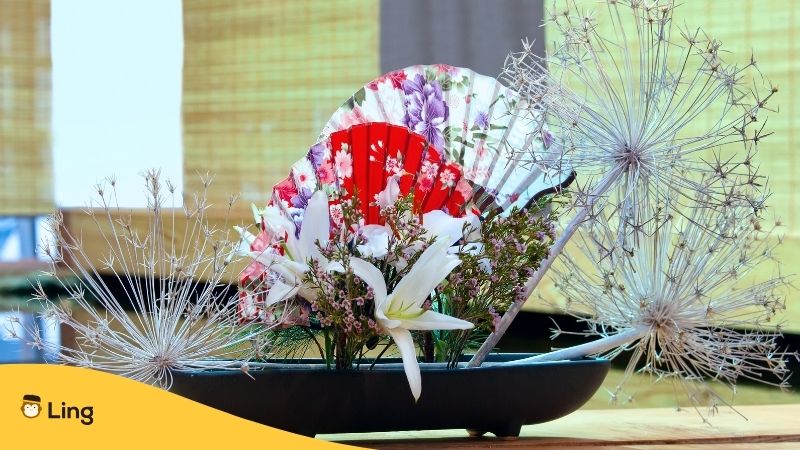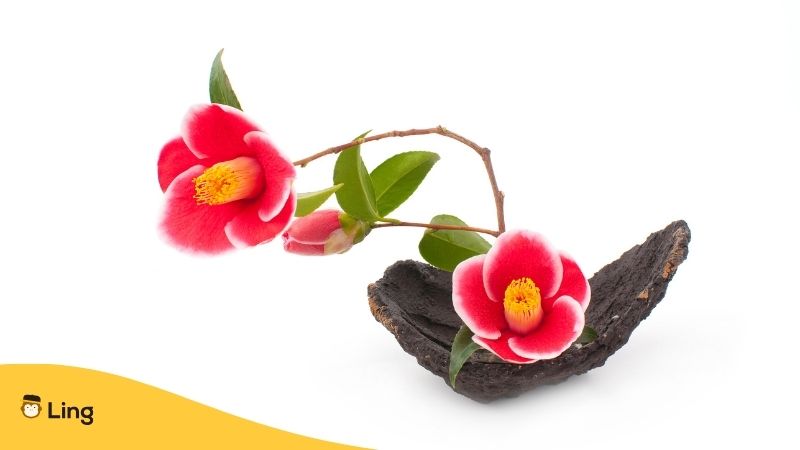When I arrived in Japan last spring for my year-long travels, I knew little about the intricate art of Japanese Ikebana (生花). All I knew was that it was a way of arranging flowers for homes, galleries, and public spaces. I shrugged it off, thinking that it was something simple. You know, like the ones you can buy from the store? But the moment I chanced upon stunning minimalist Ikebana displays… I was hooked!
What started as casual curiosity snowballed over the months into an authentic passion for Ikebana. Through books, local workshops, tea ceremonies, and even simple conversations in gardens and parks, I learned how these flower arrangements work and it has now become my favorite way of experiencing life in Japan.
As I plan my next destination, friends often ask for tips to tap into my newfound obsession during their trips to enjoy the serenity and centeredness this art fosters. Where do they sign up for a class? Can a novice with Japanese language knowledge even attempt it at home?
So, from one traveler to another, here is my #1 Best Guide to Japanese Ikebana to unfold its meditative beauty as you journey through this mesmerizing country. Let’s answer all your questions in this post!
Table of Contents
@ikebana_paradise I love ikebana #flowers #ikebana #art #floral
♬ 春江花月夜 – 古筝版 – 陌上花开
What Is Japanese Ikebana?
During my first weeks in Japan, I kept glimpsing intriguing minimalist flower arrangements displayed everywhere – homes, shops, shrines, parks. Sometimes, a single striking branch in a ceramic vase. Or a burst of cherry blossoms hovering in a metal container. Each one clearly spoke through precise shapes and negative space, but I struggled to understand their language.
Then, a local friend explained I was witnessing Ikebana, the Japanese art of flower arranging that dates back over 500 years. Its name hints at its sublime power – ikebana literally means “making flowers come alive.” More than just putting blooms in a container, it sculpts flora into living sculpture to capture fleeting beauty and evoke emotions in the viewer.
But unlike bouquets we may be used to in the West, Ikebana arrangements use minimal plant materials and empty space deliberately to drive the mood. The style can vary from sparse and wild to lush and abundant. Yet balance, colors, shapes, and lines align not just aesthetically but spiritually. Every alignment of leaves or bend of branches has intention, just like brushstrokes on mulberry paper.

Where Does Ikebana Come From?
Long before Ikebana became a refined art form, early Japanese were already finding sublime beauty in flowers. Back in the 7th century when Buddhism arrived from China, locals started humbly placing blossoms by temple altars as offerings. Over centuries, these simple gestures grew into elaborate displays honoring the ephemeral nature of life.
But Ikebana, as we know it, began blooming with Heian-era nobles from the 8th to 12th centuries. Flowery branches were woven into formal courtship rituals. Dudes penned poems celebrating cherry tree grace and sent sprigs to ladies as affection tokens. Now that’s romance!
Yet, it was the rise of the samurai class starting in the 14th century that transformed Ikebana into an esteemed art form. As wealthy warlords built grand estates and castles, they needed status symbols that projected prestige and taste. Thus began commissioning artisans and monks to create stunning formal flower arrangements for their palaces.
What’s The Purpose Of Japanese Flower Arrangements?
I was mighty confused when I first peeped at Ikebana displays in Japan. Just a couple spindly branches pokin’ every which way with bare space round them? Where’s the huge rainbow bouquets I was hankerin’ for?
But a wise sensei schooled me on the philosophy here, keepin’ it sparse lets plants shine naturally, not be crowded. Restraint reveals raw essence before petals wither, channelin’ nature’s fleeting beauty.
Negative space also pulses energy between stems, evoking that wabi-sabi view of treasuring imperfection. There is no need for picture-perfect symmetry – it’s the living asymmetry and angles that conjure landscapes in a vase, awaiting the wind’s next move.
To my Filipino eyes, Ikebana first seemed bare bones. But focusing just a few living blooms lets singular staying power and rhythms come forward. Craftin’ transient beauty not by adding on but paring down to let breath and renewal flow.

Can Tourists Experience Ikebana Flower Arrangement?
Fellow foreign peeps always grill me on where to score insider Ikebana access in Nihon without knowing the lingo or having a mad time. I mean, you can peep at exhibits at shrines and hotels, but can you really dive deeper?
Well, holler ’cause I got good news, y’all! Ikebana has spread roots for global homies through hands-on studios, demos, tea ceremonies, and even airport lounges! Major cities like Tokyo, Kyoto, and Osaka – they got private and group classes in English for tourists on the fly. There is no need for previous training – just chill on tatami mats, shaping plants into art.
Introductory workshops cost around $50-100 for 60-90 minutes, providing insight into styles like Ikenobo, Ohara, and Sogetsu while making a simple arrangement to take home. For those fiending to level up, some schools even have multi-day crash courses on history, techniques and design training to certify you as an Ikebana master!
Easy Japanese Phrases For Ikebana
Ikebana o shitte imasu ka?
Japanese script: いけばなを知っていますか?
Translation: Do you know ikebana?
Ikebana no jugyō o uketai desu
Japanese Script: いけばなの授業を受けたいです
Translation: I want to take an ikebana lesson.
Shashin o totte mo ī desu ka?
Japanese script: 写真を撮ってもいいですか?
Translation: May I take photos?
Sukina hana wa nan desu ka?
Japanese script: 好きな花は何ですか?
Translation: What’s your favorite flower?
Ready To Master This Japanese Flower Arranging Technique?
Even with Ikebana branching out creatively across different schools, the search for wabi-sabi beauty stays timeless. So soak in those minimalist flower vibes whether you’re temple hopping in Kyoto or at a Tokyo tea party. Now, if you wanna skip fumbling translations and learn from a true homegrown Ikebana master, you gotta download the Ling app!
For real, Ling serves straight-fire foreign language lessons on there, covering hella topics to take your Japanese comprehension to the next level. It’s perfect for keeping those travel memories fresh, whether you were vibing on ikebana displays, going ham at a sushi counter, or getting hype in Harajuku boutiques.



































































